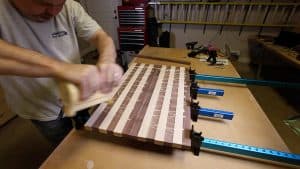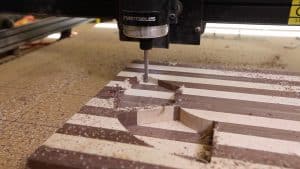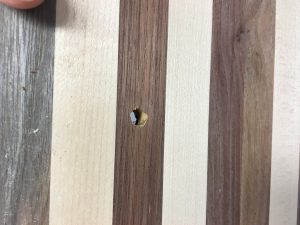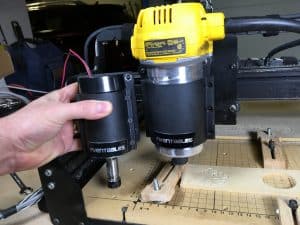Most orders for IN STOCK items placed by 12PM CST M-F ship SAME DAY. Orders for custom items and prints may take additional time to process.
Geek Tip: Download the Party Serving Tray SketchUP and SVG files if you want to try this experiment yourself and share your results.


Following that, I would then judge the quality of the completed product, comparing the differences and craftsmanship of each one. I would then declare a winner, or a tie depending on the points scored and time taken to achieve the results.
This is one of those situations where the results I expected and what actually happened are almost opposite. What I expected was the CNC to take much longer than my hand version. I had already done the calculations on the G-Code and knew I was looking at 7 hours for the CNC to finish. However, I also expected the quality of the CNC work to be much better. Straighter lines, less waviness to the pattern, etc. I had already planned out that the winner would most likely be hand, but only by a very slim margin because the CNC would take much much longer to complete, negating much of the benefits.

The first fail was in the homing sequence. Even after checking everything I still cannot figure out what went wrong with this one. Somehow the entire design got pushed up about 3/4 of an inch. This meant the top portion of the party serving tray ran out of material. I knew I could save this, because I could simply laminate another section of maple to the tray and finish the outside cut, so at this point I decided to allow the tray to complete and correct this when we got to the outer tool path.
After over 7 hours of milling, and while just begging to cut the center dish out the belt on the X-Carve slipped. This moved the center dish to one side by about 1/8 inch or so. From a design perspective this was not a recoverable event. However, we were so close to being finished I decided to let it go. It would just become part of my score.
During some of the last few passes of the center dish the DeWalt DWP611 started to smoke. I was across the room, but could smell the burn smell. I ran across the room to arrive just in time to watch as the bit fell out of the collet and drilled a hole all the way through the party serving platter, the bed of the X-Carve and the started to attack my work bench top. There was no recovering from this. The X-Cave had failed miserably and had lost the competition. Man had won.
Lots of you assumed after this competition that I was now anti-CNC. Or at least anti-X-Carve. This is not the case. I still use my X-Carve regularly and I still plan to use the CNC often. I just plan to use the right tool for the job and these hobby class CNC machines are not up the bigger jobs. Also, the CNC is fantastic for making templates. Had I not been doing a Man vs CNC competition, I would have made the template for the serving tray on the CNC, rather than the scroll saw. It would have been more accurate than the scroll saw version and is the perfect type of CNC operation.

I want to always be as fair and honest as I can be. In the interest of that fairness I want to point out that I ran the machine at a higher than the recommended depth-per-pass than that Easel recommends. I did this because originally the estimate was 13 hours of carving time. I didn’t have 13 hours to burn. Also, I had replaced the default 24 Volt Spindle with the DeWalt DWP611 router. In addition I bought a very high quality 2 flute bit. I thought with that combination I would be able to exceed the recommendations pretty easily. I did several test cuts in some scrap maple (the harder of the two woods) and both cuts were perfect. I can’t know if this feed rate was what led to some of the problems. But I will say this with certain authority: Running the X-Carve for 7 hours has to be less stress on the spindle than 13. Lowering the depth-per-pass might have prevented the belt from slipping, but I seriously doubt the DeWalt would have survived for 13 hours of continuous use.
So with that, Happy CNCing!
If you like our content maybe consider upgrading to Premium. You’ll get access to
4 Responses
I don’t think you are. A hobby CNC gets mixed results. If you had access to a Hitachi Seiki mill with a tool changer, you could knock this out in minutes, provided you had the proper tooling for wood working and since you can’t use liquid cooling on wood, I suppose one would need to slow the process and employ air shot cooling. But unless you have $200K to $500K laying around it would be unrealistic to use such a machine. So the little guy can’t quite cut it, that’s ok, it has limitations. I rather enjoyed seeing your manual build of this tray, turned out very nice..
The key advantage of CNC should be repeat-ability so it’s advantages for a one off are reduced. I’ve seen this with 3D printers too, people making stuff that would be better made by hand or on a lathe just because that’s the machine they have.
I’m inclined to agree with Derrick, this is in some ways just a test of how suitable your CNC machine is for this project. I don’t think it would take 13 hours (or even 1 hour) on a regular commercial CNC router.
I sympathise with the fails. I’ve had similar inexplicable fails on my Taig. I have resorted to shrugging and moving on.
The finished piece is gorgeous.
That said, I think this speaks to the weakness of the x-carve, not CNC in general. I made a similar dish out of old-growth quatersawn red oak on my diy machine. It took about 30 minutes, including roughing and finishing passes. My rig has belt-drive on the 1500mm X axis, and lead screws for the others. I’ve never had an issue with the belt slipping. (Though, I do check tension and re-tighten the thing every few weeks.)